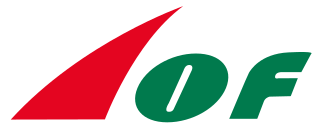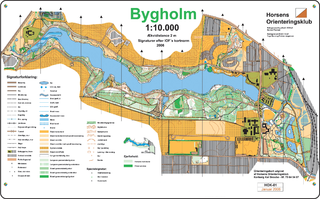Related Research Articles

The International Orienteering Federation (IOF) is the international governing body of the sport of orienteering. The IOF head office is located in Karlstad, Sweden. The IOF governs four orienteering disciplines: foot orienteering, mountain bike orienteering, ski orienteering, and trail orienteering.
Ola Skarholt, was a Norwegian orienteering competitor. He became Relay World Champion in 1970 as a member of the Norwegian winning team, which also consisted of Stig Berge, Per Fosser and Åge Hadler. Skarholt placed fourth in the individual contest.

An orienteering map is a map specially prepared for use in orienteering events. It is a large-scale topographic map with extra markings to help the participant navigate through the course.
The Finnish Orienteering Federation is the governing body for the sport of orienteering in Finland. The federation was founded in 1945 and has approximately 60,000 members.

The Italian Orienteering Federation is the national orienteering federation of Italy. It is a full member of the International Orienteering Federation.
Orienteering Australia is the National organisation responsible for the governing, organisation and promotion of orienteering in Australia. It is a Full Member of the International Orienteering Federation. Orienteering Australia has its own publication The Australian Orienteer.

The French Orienteering Federation (FFCO) is the national orienteering Federation of France. It is a full member of the International Orienteering Federation.

Belgian Orienteering Federation ABSO-BVOS is the national Orienteering Association in Belgium. It is recognized as the orienteering association for Belgium by the International Orienteering Federation, of which it is a member.
The Český svaz orientačních sportů (ČSOS) is the national Orienteering Association in Czech Republic. It is recognized as the orienteering association for the Czech Republic by the International Orienteering Federation, of which it is a member.
The Danish Orienteering Federation is the national Orienteering Association in Denmark. It is recognized as the orienteering association for Denmark by the International Orienteering Federation, of which it is a member.
The history of orienteering begins in the late 19th century in Sweden, where it originated as military training. Over the course of the late 19th and early 20th century, orienteering emerged first as a military competition in Nordic countries and then as a mass participation sport, before becoming a competitive sport with an international governing body.
The Norwegian Orienteering Federation is the national Orienteering Association in Norway. It is recognized as the orienteering association for Norway by the International Orienteering Federation, of which it is a member. The association was founded 1 October 1945, and is a member of the Norwegian Confederation of Sports (NIF). Its first chairman was Kaare Thuesen. In 1946 NOF had 204 associated clubs, with just above 7,000 members. The number of clubs and associated members increased gradually through the 1950s, 1960s and 1970s, and peaked in 1984 with 630 clubs and 34,000 members, and 35,000 members and 620 clubs in 1985. The next twenty years saw a decline in the number of clubs and members. As per December 2007 Norges Orienteringsforbund had 400 associated clubs and just above 24,000 members, distributed over eighteen districts.
Deutscher Turner Bund, Abteilung Sport Orientierungslauf is the national Orienteering Association in Germany. It is recognized as the orienteering association for Germany by the International Orienteering Federation, of which it is a member.
The Hungarian Orienteering Federation is the governing body for orienteering in Hungary. It is recognized as Hungary's national orienteering association by the International Orienteering Federation (IOF), of which it is a member.
Swiss Orienteering is the national Orienteering Association in Switzerland. It is recognized as the orienteering association for Switzerland by the International Orienteering Federation, of which it is a member.
New Zealand Orienteering Federation is the national Orienteering Association in New Zealand. It is recognized as the orienteering association for New Zealand by the International Orienteering Federation, of which it is a member.
Per Kristiansen is a former Norwegian orienteering competitor who competed in the 1950s and 1960s, and later served as an official for the sport at a national level. He became National Champion both individually and in relay, and was twice the individual medal winner at the Scandinavian Championships. He participated at the two first European Orienteering Championships, with a silver medal in relay as his best result.
The Norwegian Athletics Association is the national governing body for the sport of athletics in Norway, including track and field, road running, cross country running and racewalking. The association is a member of the Norwegian Olympic and Paralympic Committee and Confederation of Sports, and a member of the International Association of Athletics Federations and European Athletics.
Johan Chr. Schønheyder was a Norwegian insurance manager, orienteer and sports official.
Odd E. Hopp was a Norwegian Scout leader, orienteer and sports official.
References
- 1 2 3 Bakken, Tor Chr., ed. (2008). "Jan Martin Larsen". Budstikkas store Asker og Bærum-leksikon (in Norwegian). Oslo: Kunnskapsforlaget. p. 301. ISBN 978-82-573-1534-4.
- 1 2 Werp, Hans L. (1987). "Orienteringskartets historie". Orienteringsidrettein in Norge gjennom 90 år (in Norwegian). Norges Orienteringsforbund. pp. 161–184.